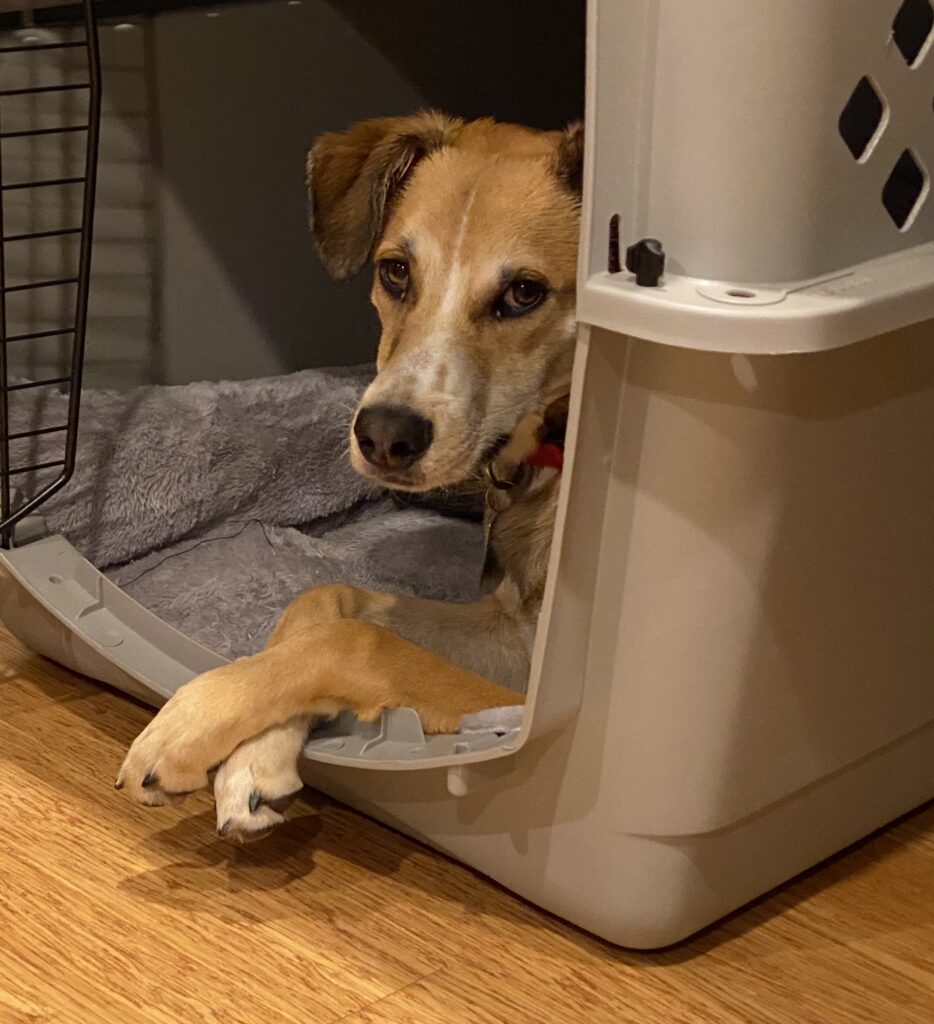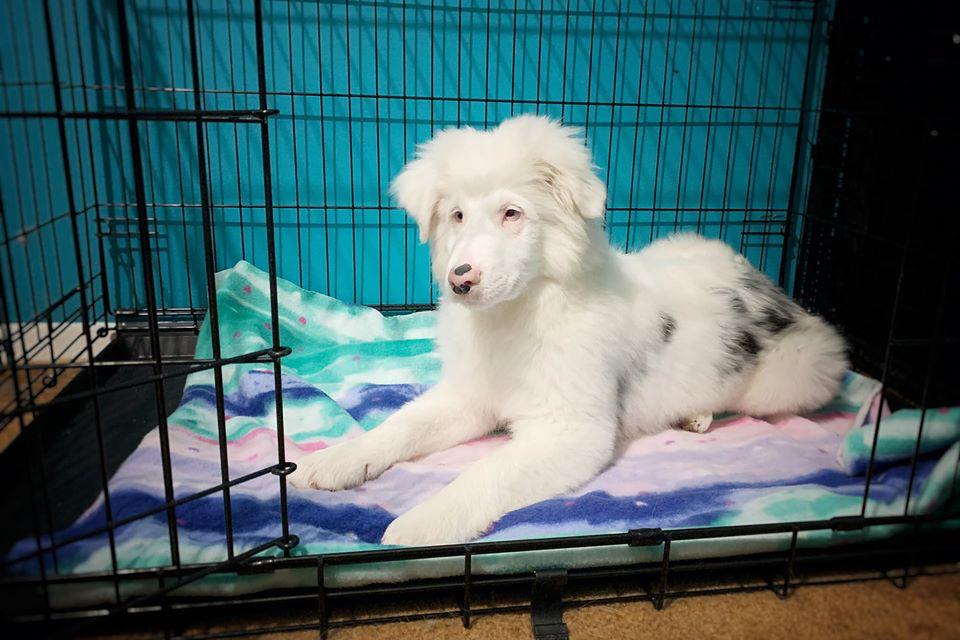I grew up before crating your dog was a thing. When I first heard about people crating dogs, I remember being quite horrified. Locking a dog in a box seemed so unnecessary and quite frankly, cruel, that I just discounted it out of hand and pretty much forgot about it.
Fast forward a lot of years, and crating dogs is a pretty mainstream thing nowadays. After raising, training, and working with over a thousand rescue dogs and puppies during the past decade I have changed my mind about crates and if you feel as I once did about them, I would like to give you a few good reasons to reconsider.
10 Reasons to Love Crates
1. Veterinary hospitalization
While we hope our dogs never have to be hospitalized, many, if not most pets will end up in a cage at a veterinary clinic at some point in their lives. Most dogs are already anxious and uneasy at the vet, and if your dog is comfortable and feels safe in a crate it can help reduce the stress of being caged after surgery or treatment.
2. Groomer visits
If you have a dog who needs to be groomed professionally, the ability to relax and feel calm in a cage or crate before and after grooming will significantly reduce your dog’s stress while at the groomer.
3. Moving
We live in a mobile world. Many people will make a major move during their dog’s lifetime, and frequently the move will involve air travel. Conditioning your dog to love being in his crate will make flying so much easier on everyone and if traveling overland, crating can prevent your dog from being lost en-route to a new home.
4. Dog Sports-Dog Shows
If you decide to participate in a sport like nose work, agility, flyable, or many others, your dog will have to wait between turns in a crate. If your dog loves his crate, he will perform better and be better able to rest and relax between trials.
5. Driving
Crating a dog when driving keeps the dog safely contained and can prevent accidents. It can also reduce or even eliminate barking at passing dogs, people, or other stimuli.
6. Vacations
Many of us love to vacation with our dogs. More and more hotels and rentals are pet-friendly and welcome pets, which makes holidaying with our pets doable and fun. Most hotels ask that dogs be crated when the owner is not in the room, which makes a lot of sense. It keeps Fido from damaging the room, the cleaning staff from being bitten, and your pet from escaping if the door to the room is opened. You can dine in a restaurant peacefully, knowing that Fido is safely locked inside his crate in a quiet, air-conditioned room. If your dog is happy and comfortable in his crate, he will be surrounded by familiarity within a strange new space, and be calmer and happier because of it.
If you can’t take Fido to Aunt Sue’s birthday party in Iowa, you may end up having to board him. Many boarding kennels use crates, and for those that don’t, taking Fido’s known crate and bedding will give him a familiar smelling place to sleep, also reducing the stress of not being with you.
7. Visitors and Workmen
Not all visitors are comfortable around dogs, and not all dogs are comfortable around visitors. If your 84 year old granny arrives in a white pantsuit, it might be safer to park Fido safely in his crate to prevent any chance of Gran being bowled over. And when your sister comes over with her two perfectly monstrous 4 year olds who won’t stop pestering Fido, the crate becomes a sanctuary for him indeed. The plumber may not appreciate the close supervision that Fido gives him while he works, and having a strange headless man lying on the floor half in and half out of the cupboard is a weird picture for the calmest of dogs. Crating Fido while the workmen are hard at work might be less stressful for everyone involved.
8. Families and Dinnertime
Dogs who live with families have a lot on their plates (pun intended) every day. Family life can be chaotic and loud and sometimes it is difficult for even supermoms to keep track of everything that is going on. Crating Fido with a delicious stuffed Kong while prepping and serving dinner can be a great aid to chaos reduction and prevents table begging, too.
9. Puppyhood and Adolescence
Frankly, after raising somewhere in the neighborhood of 700 puppies, I can’t even imagine surviving puppyhood without a crate! House training goes so much more quickly, and even errorlessly when crates are correctly employed. The swath of destruction that these razor-toothed little Perses’ cut as they roam through your home is considerably lessened and contained if puppies are crated when you are not able to actively supervise them. Plus-house training (which should probably have a number all of it’s own) is simplified by about 1000%. Crating tired, ‘empty’ puppies in a properly sized crate when your eagle-eyes are otherwise occupied prevents potty accidents and speeds up house training significantly. Canine adolescents are no different than teenagers of any species. Crating them when we can’t supervise them helps ensure that they don’t get into things we’d prefer they didn’t, develop habits humans don’t like, and protects all our hard training.
10. Canine ‘Man Caves’
Sometimes navigating the daily hustle and bustle of human life is a lot for our dogs. Having a comfy crate set up in a quiet area gives our dogs a place of their own where they can retreat to when they would just like some alone time or a place to nap in peace.
Are you convinced yet? Good! If you are ready to try crate training your dog, here is a link to a sample training plan and a link to my video tutorial.

Some words of caution: Like any equipment, crates can be misused. Before crating any dog or puppy, you must invest some patient and careful training to ensure that the crate is a safe and comfortable place for the dog. Simply pushing an animal into a crate and walking away could cause the dog to panic and create a real (and well founded) aversion to the crate. So you need to move at the dog’s pace and use an incremental plan to train him to feel comfortable in the crate and build up to being able to leave him alone in it.If your dog already has an aversion to being crated, you’ll need to break the plan down more and it will take longer to crate train.
Crates can be over-used. It is inhumane to crate a dog all day while you are at work. My general rule of thumb is crate no longer than 3 hours per day during the day for an adult dog (and only after the dog has had ample opportunity to exercise and relieve himself). Most adult dogs can sleep all night in a crate (8 hours). Puppies should not be crated longer than about 20 minutes per month of age during the daytime, and only crated when they are “empty”.
If your dog is anxious or panicky about being closed in a crate, you MUST stop and go back in the training plan to where he is comfortable and build back up to Fido being comfortable. If he is still not comfortable at an easier step, back up again. If you and he are still struggling, contact a competent trainer for support.
**Crates are frequently contraindicated for dogs suffering from separation anxiety. These dogs often additionally present with confinement anxiety and crating them is inhumane. The answer is not a sturdier crate. You and your dog need more help. Please contact a Certified Separation Anxiety Trainer (CSAT) or SA Pro Trainer for support.
Crates are available in a variety of materials. Wire and rigid plastic crates are the most common. Fabric crates are not sturdy enough for any but the calmest dogs. Crates need to be correctly sized. Your dog should be able to stand up with head clearance, and be able to turn around easily and stretch out fully in his crate. A crate that is too large for puppies will allow them to use one end of the crate as a toilet and the other end to rest, so don’t buy an overly large crate for your pup.

